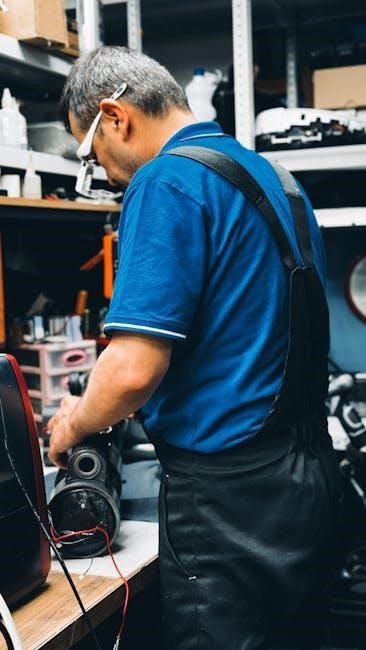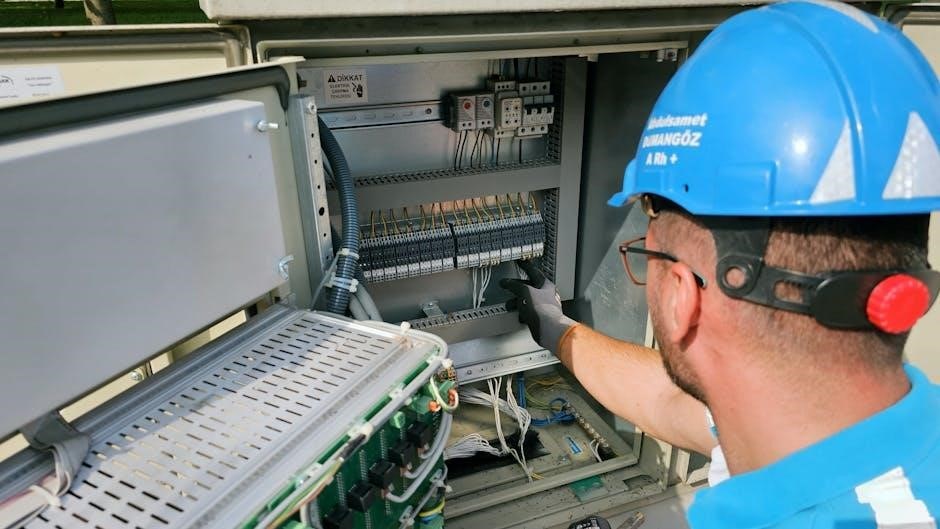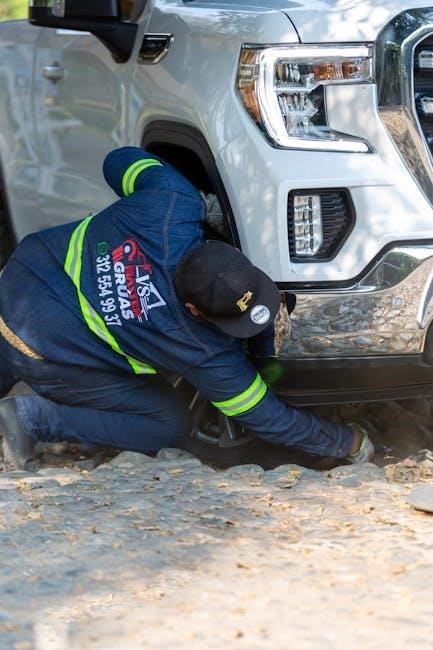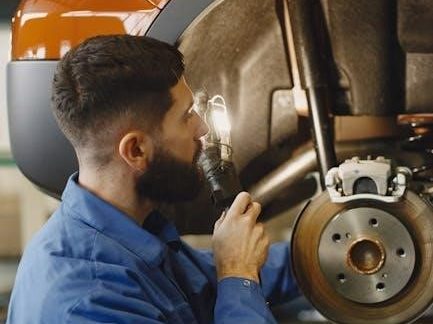Welcome to the Raypak Pool Heater Troubleshooting Manual, your comprehensive guide to diagnosing and resolving common issues with your pool heating system․ This manual is designed to help you identify and fix problems efficiently, ensuring your pool remains warm and comfortable․ Whether you’re dealing with ignition failures, low gas pressure, or error codes, this guide provides step-by-step solutions to get your heater running smoothly․ Regular maintenance and troubleshooting are key to extending the lifespan of your Raypak pool heater and maintaining optimal performance․ Let’s dive into the details and keep your pool heating system in top shape year-round․
Overview of the Raypak Pool Heater System
The Raypak pool heater system is a gas-fired, high-efficiency heating solution designed for residential and commercial pools․ It features a durable bronze or polymer heat exchanger, ensuring long-lasting performance and corrosion resistance․ The system includes a burner assembly, control panel, and safety switches to regulate and monitor operation․ Raypak heaters are known for their reliability, low NOx emissions, and user-friendly controls․ Proper installation and regular maintenance are essential to optimize efficiency and extend the heater’s lifespan․ Understanding the system’s components and operation is key to effective troubleshooting and ensuring consistent pool heating performance․
Importance of Regular Maintenance and Troubleshooting
Regular maintenance and timely troubleshooting are crucial for ensuring the optimal performance and longevity of your Raypak pool heater․ Neglecting routine checks can lead to reduced efficiency, higher energy costs, and premature wear of components․ By addressing issues like clogged filters, faulty sensors, or gas valve malfunctions promptly, you can prevent minor problems from escalating into costly repairs․ A well-maintained heater not only extends its lifespan but also enhances safety, ensuring reliable and consistent pool heating throughout the year․ Stay proactive to keep your system running smoothly and efficiently․
Common Issues with Raypak Pool Heaters
Raypak pool heaters often face issues like ignition failure, low gas pressure, insufficient airflow, or faulty venting․ These problems can significantly hinder performance and require timely attention;
- Pilot Light or Ignition Failure
- Low Gas Pressure or Insufficient Air Supply
- Faulty Venting or Blocked Burner Orifice
Pilot Light or Ignition Failure
Ignition failure in Raypak pool heaters is often linked to a clogged pilot orifice or a damaged pilot assembly․ The pilot light is essential for igniting the burners, and if it fails, the heater won’t start․ A clogged pilot orifice can be caused by dirt or debris, while a faulty pilot assembly may require replacement․ Additionally, a defective flame sensor can prevent the gas valve from opening, halting the ignition process․ Regular cleaning of the pilot orifice and inspecting the flame sensor can help resolve these issues․ Always refer to the manual for detailed troubleshooting steps․
Low Gas Pressure or Insufficient Air Supply
Low gas pressure or insufficient airflow can prevent your Raypak pool heater from functioning properly․ Check the gas supply line for leaks or obstructions and ensure the regulator is set correctly․ Blocked venting or restricted airflow around the unit can also cause issues․ Verify that the surrounding area is clear and that the blower is operating correctly to provide adequate airflow․ If the problem persists, consult a professional to adjust the gas pressure or inspect the system for hidden blockages․ Proper airflow is crucial for efficient and safe heater operation․
Faulty Venting or Blocked Burner Orifice
Faulty venting or a blocked burner orifice can disrupt your Raypak pool heater’s operation․ Over time, dirt, debris, or calcium deposits may accumulate in the burner orifice, restricting gas flow; Similarly, improper venting or blockages in the venting system can prevent proper airflow, leading to ignition issues or poor combustion․ To resolve this, clean the burner orifice with a soft brush and ensure the venting system is clear․ If the problem persists, consider replacing the burner orifice or consulting a professional to inspect the venting setup for optimal performance and safety․

Troubleshooting Steps for Ignition Failure
Identify and address ignition failure by checking the pilot orifice, flame sensor, and gas valve․ Ensure the blower operates correctly and airflow is unobstructed for proper combustion and ignition․
Checking the Pilot Orifice and Assembly
Begin by inspecting the pilot orifice for blockages caused by dirt or debris․ Clean the orifice with a small brush or compressed air to ensure proper gas flow․ If the pilot light still doesn’t ignite, check the pilot assembly for damage or wear․ Remove and clean the assembly thoroughly, ensuring all components are free from obstructions․ If issues persist, consider replacing the pilot orifice or assembly to restore proper ignition․ Regular maintenance of these components is essential for reliable heater operation and safety․
Inspecting the Flame Sensor and Gas Valve
Examine the flame sensor for dirt or corrosion, as a faulty sensor can prevent the gas valve from opening․ Use a multimeter to test the sensor’s voltage output; a reading outside the 145-195 mV range indicates a defect․ Inspect the gas valve’s wiring connections and solenoid operation․ If the valve fails to open, replace it․ Ensure the flame sensor is clean and properly positioned to detect the pilot flame accurately․ A malfunctioning flame sensor or gas valve can disrupt ignition, so prompt inspection and maintenance are crucial for reliable operation․
Verifying Blower Operation and Airflow
Ensure the blower is functioning correctly to provide adequate airflow, essential for proper ignition and heater operation․ Check if the blower is running and verify its wiring connections․ Use a multimeter to test voltage supply to the blower motor․ If the blower is not operating, inspect for blockages or damage․ Clean or replace the blower as needed to restore airflow․ Proper blower function prevents overheating and ensures reliable ignition, making it a critical step in troubleshooting your Raypak pool heater․
Understanding Error Codes and Safety Switches
This section explains how to interpret error codes and identify tripped safety switches, such as the high limit, water pressure, or rollout switch, to diagnose issues accurately․
High Limit Switch, Water Pressure Switch, and Rollout Switch
The high limit switch, water pressure switch, and rollout switch are essential safety features in your Raypak pool heater․ The high limit switch trips if the temperature exceeds safe levels, while the water pressure switch ensures proper water flow․ The rollout switch activates if there’s a combustion issue․ If any of these switches trip, the heater shuts down to prevent damage․ Always identify and address the root cause before resetting the switches․ Refer to your manual for specific error codes and reset procedures to safely restore operation․
Resetting the Heater After a Safety Switch Trip
Resetting your Raypak pool heater after a safety switch trip is a straightforward process․ First, ensure the heater is turned off and allow it to cool for 20-30 minutes․ Identify and address the underlying cause, such as excessive temperature or low water pressure, before proceeding․ Once resolved, locate the reset button on the high limit switch or rollout switch and press it firmly․ Turn the heater back on and monitor its operation․ If the issue persists, consult your manual or contact a professional for further assistance․ Always prioritize safety when handling electrical or gas components․

Maintenance and Repair Tips
Regular maintenance is crucial for optimal performance․ Clean the pool filter, inspect damaged components, and ensure proper airflow․ Address issues promptly to prevent major repairs and extend lifespan․
Cleaning the Pool Filter and Pump
Cleaning the pool filter and pump is essential for maintaining your Raypak pool heater’s efficiency․ A clogged filter restricts water flow, which can lead to ignition failures and reduced performance․ Regularly backwash the filter and clean the skimmer basket to ensure optimal flow․ Inspect the pump impeller for debris and damage, and repair or replace it as needed․ Proper maintenance prevents blockages and ensures your heater operates smoothly, avoiding common issues like low pressure or insufficient airflow․ Schedule filter cleaning every 2-3 months for peak performance․
Inspecting and Replacing Damaged Components
Inspecting and replacing damaged components is crucial for maintaining your Raypak pool heater․ Regularly check the pilot orifice, flame sensor, and gas valve for wear or blockages․ If the pilot orifice is clogged, clean it gently with a small brush or replace it if damaged․ Inspect the flame sensor for corrosion and ensure it detects the pilot flame accurately․ Damaged or faulty components like the gas valve or burner tubes should be replaced promptly to prevent ignition failures and ensure safe operation․ Always refer to the Raypak manual for specific replacement guidelines․

Advanced Troubleshooting Techniques
Advanced troubleshooting involves using specialized tools like multimeters and endoscopes to diagnose complex issues․ Measure voltage at gas valves and inspect internal components for blockages or damage․ This approach helps pinpoint hidden problems quickly and effectively, ensuring your Raypak pool heater operates smoothly․
Using a Multimeter for Gas Valve Testing
To test the gas valve using a multimeter, set the device to measure millivolts (mV)․ Connect the multimeter probes to the solenoid terminals on the gas valve․ A normal reading should be between 145-195 mV․ If the reading falls outside this range, the gas valve is faulty and needs replacement․ This method helps identify issues with the valve’s electrical operation, ensuring accurate diagnosis and repair․ Always refer to the Raypak troubleshooting manual for specific instructions and safety precautions during testing․

Checking for Blockages in Burner Tubes
Blockages in burner tubes can prevent proper ignition and reduce heater efficiency․ To check for blockages, turn off the heater and allow it to cool․ Remove the burner tubes and inspect for debris, dirt, or calcium buildup․ Clean the tubes with a soft brush or replace them if damaged․ Ensure all connections are secure and free from obstructions․ Refer to the Raypak troubleshooting manual for detailed steps and safety precautions․ Regular cleaning helps maintain optimal performance and prevents ignition issues․ Always follow manufacturer guidelines for maintenance and repair․
Regular maintenance and prompt troubleshooting are essential for optimal Raypak pool heater performance․ By following this manual, you can prevent future issues and ensure efficient operation․ Proper care extends lifespan and reliability, keeping your pool comfortable year-round․ Always refer to the manual for precise guidance and safety measures․
Preventative Measures to Avoid Future Issues
Regular maintenance is crucial to prevent Raypak pool heater issues․ Schedule annual servicing by an authorized technician to ensure optimal performance․ Clean the pool filter every 2-3 months and check for blockages in burner tubes․ Properly winterize the heater to avoid damage from freezing temperatures․ Maintain correct water chemistry levels and ensure sufficient airflow around the unit․ Keep the area around the heater clear of debris and inspect electrical connections regularly․ By following these steps, you can extend the lifespan of your heater and avoid unexpected breakdowns․
